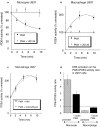Remodelling of the PDE4 cAMP phosphodiesterase isoform profile upon monocyte-macrophage differentiation of human U937 cells
- PMID: 15066910
- PMCID: PMC1574950
- DOI: 10.1038/sj.bjp.0705770
Remodelling of the PDE4 cAMP phosphodiesterase isoform profile upon monocyte-macrophage differentiation of human U937 cells
Abstract
Monocytes and macrophages provide key targets for the action of novel anti-inflammatory therapeutics targeted at inhibition of PDE4 cAMP-specific phosphodiesterases. PDE4 enzymes provide the dominant cAMP phosphodiesterase activity in U937 human monocytic cells. Differentiation of U937 monocytic cells to a macrophage-like phenotype causes a marked reduction in total cellular PDE4 activity. Monocytic U937 cells express the long PDE4A4, PDE4D5 and PDE4D3 isoforms plus the short PDE4B2 isoform. Differentiation of U937 cells to a macrophage-like phenotype causes a marked downregulation of PDE4D3 and PDE4D5, elicits a marked upregulation of PDE4B2 and induces the novel PDE4A10 long isoform. Comparable patterns are found in human peripheral blood monocytes and macrophages differentiated from them. Immunopurification of PDE4 subfamilies identifies long PDE4D isoforms as providing the major PDE4 activity in U937 monocytic cells. In U937 macrophage-like cells, the activity of the short PDE4B2 isoform predominates. No indication of either the expression or induction of PDE4C was evident. Activation of ERK exerts an inhibitory effect on total PDE4 activity in monocytic U937 cells, where the activity of long PDE4 isoforms predominates. The effect of ERK activation is switched to one of overall stimulation of total PDE4 activity in macrophage U937 cells, where the activity of the short PDE4B2 isoform predominates.10 The profound differentiation-induced changes in PDE4 isoform profile identified here suggests that the development of inhibitors specific for particular PDE4 isoforms may allow for selective effects on monocytes and macrophages to be achieved.
Figures







Similar articles
-
Action of rolipram on specific PDE4 cAMP phosphodiesterase isoforms and on the phosphorylation of cAMP-response-element-binding protein (CREB) and p38 mitogen-activated protein (MAP) kinase in U937 monocytic cells.Biochem J. 2000 Apr 15;347(Pt 2):571-8. doi: 10.1042/0264-6021:3470571. Biochem J. 2000. PMID: 10749688 Free PMC article.
-
Differential expression of PDE4 cAMP phosphodiesterase isoforms in inflammatory cells of smokers with COPD, smokers without COPD, and nonsmokers.Am J Physiol Lung Cell Mol Physiol. 2004 Aug;287(2):L332-43. doi: 10.1152/ajplung.00384.2003. Epub 2004 Mar 26. Am J Physiol Lung Cell Mol Physiol. 2004. PMID: 15047569
-
Hypoxia-induced remodelling of PDE4 isoform expression and cAMP handling in human pulmonary artery smooth muscle cells.Eur J Cell Biol. 2006 Jul;85(7):679-91. doi: 10.1016/j.ejcb.2006.01.006. Epub 2006 Feb 3. Eur J Cell Biol. 2006. PMID: 16458997
-
The role of ERK2 docking and phosphorylation of PDE4 cAMP phosphodiesterase isoforms in mediating cross-talk between the cAMP and ERK signalling pathways.Biochem Soc Trans. 2003 Dec;31(Pt 6):1186-90. doi: 10.1042/bst0311186. Biochem Soc Trans. 2003. PMID: 14641023 Review.
-
Phosphodiesterase inhibitors in airways disease.Eur J Pharmacol. 2006 Mar 8;533(1-3):110-7. doi: 10.1016/j.ejphar.2005.12.059. Epub 2006 Feb 2. Eur J Pharmacol. 2006. PMID: 16458289 Review.
Cited by
-
The therapeutic profile of rolipram, PDE target and mechanism of action as a neuroprotectant following spinal cord injury.PLoS One. 2012;7(9):e43634. doi: 10.1371/journal.pone.0043634. Epub 2012 Sep 19. PLoS One. 2012. PMID: 23028463 Free PMC article.
-
Phosphodiesterase-4 inhibition alters gene expression and improves isoniazid-mediated clearance of Mycobacterium tuberculosis in rabbit lungs.PLoS Pathog. 2011 Sep;7(9):e1002262. doi: 10.1371/journal.ppat.1002262. Epub 2011 Sep 15. PLoS Pathog. 2011. PMID: 21949656 Free PMC article.
-
Morphometric Characterization of Rat and Human Alveolar Macrophage Cell Models and their Response to Amiodarone using High Content Image Analysis.Pharm Res. 2017 Dec;34(12):2466-2476. doi: 10.1007/s11095-017-2176-5. Epub 2017 May 24. Pharm Res. 2017. PMID: 28540501 Free PMC article.
-
MEK1 binds directly to betaarrestin1, influencing both its phosphorylation by ERK and the timing of its isoprenaline-stimulated internalization.J Biol Chem. 2009 Apr 24;284(17):11425-35. doi: 10.1074/jbc.M806395200. Epub 2009 Jan 19. J Biol Chem. 2009. PMID: 19153083 Free PMC article.
-
Characteristic DNA methylation profiles in peripheral blood monocytes are associated with inflammatory phenotypes of asthma.Epigenetics. 2014 Sep;9(9):1302-16. doi: 10.4161/epi.33066. Epub 2014 Aug 11. Epigenetics. 2014. PMID: 25147914 Free PMC article.
References
-
- AHMAD F., GAO G., WANG L.M., LANDSTROM T.R., DEGERMAN E., PIERCE J.H., MANGANIELLO V.C. IL-3 and IL-4 activate cyclic nucleotide phosphodiesterases 3 (PDE3) and 4 (PDE4) by different mechanisms in FDCP2 myeloid cells. J. Immunol. 1999;162:4864–4875. - PubMed
-
- ARM J.P., LEE T.H. The pathobiology of bronchial asthma. Adv. Immunol. 1992;51:323–382. - PubMed
-
- BAILLIE G., MACKENZIE S.J., HOUSLAY M.D. Phorbol 12-myristate 13-acetate triggers the protein kinase A-mediated phosphorylation and activation of the PDE4D5 cAMP phosphodiesterase in human aortic smooth muscle cells through a route involving extracellular signal regulated kinase (ERK) Mol. Pharmacol. 2001;60:1100–1111. - PubMed
-
- BARNES P.J. New concepts in chronic obstructive pulmonary disease. Annu. Rev. Med. 2003;54:113–129. - PubMed
Publication types
MeSH terms
Substances
Grants and funding
LinkOut - more resources
Full Text Sources
Miscellaneous

